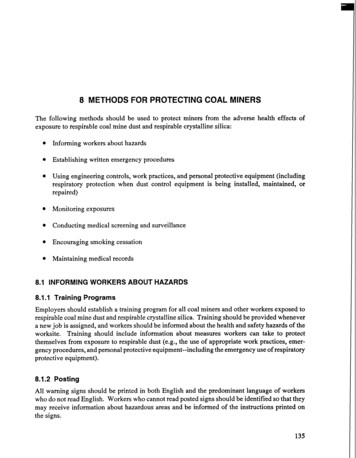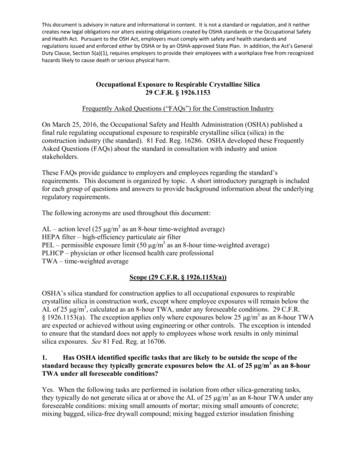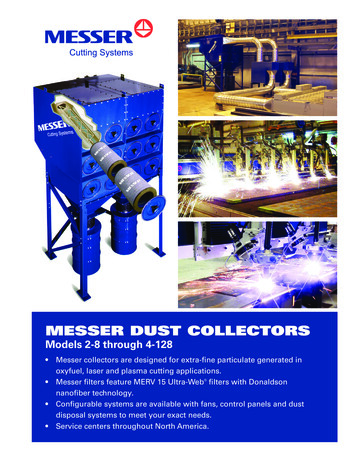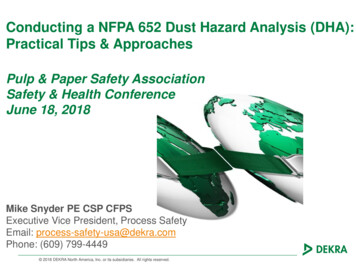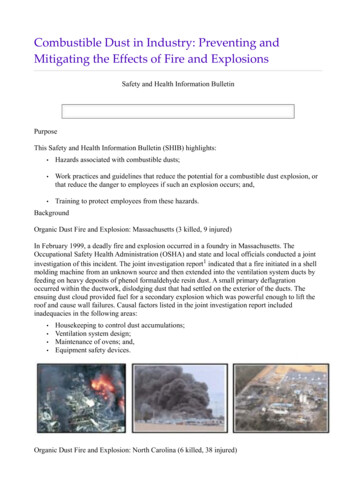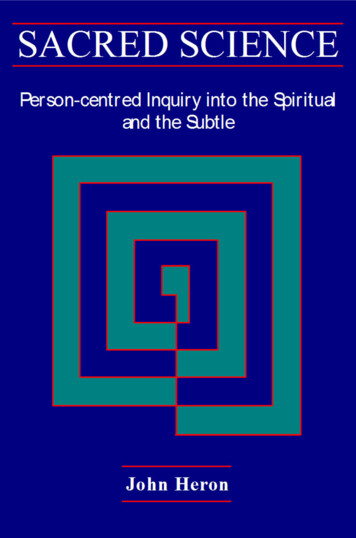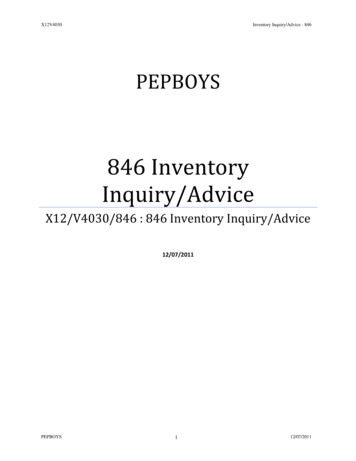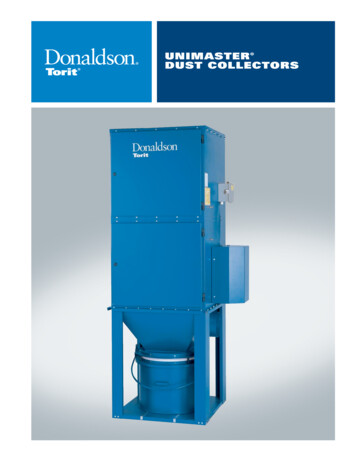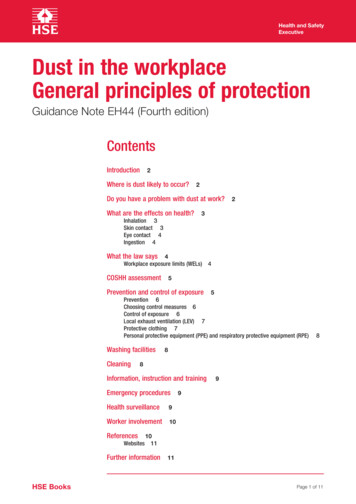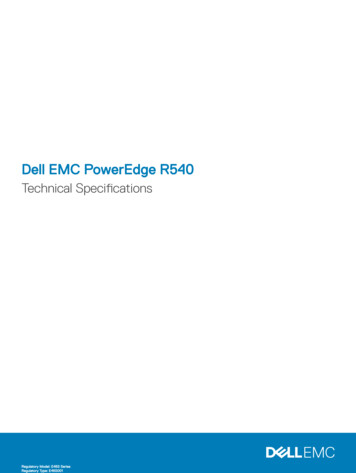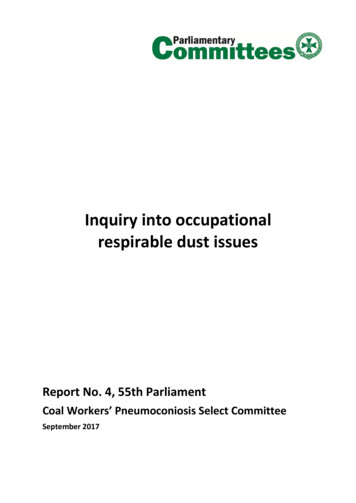
Transcription
Inquiry into occupationalrespirable dust issuesReport No. 4, 55th ParliamentCoal Workers’ Pneumoconiosis Select CommitteeSeptember 2017
Coal Workers’ Pneumoconiosis Select CommitteeChairMrs Jo-Ann Miller MP, Member for BundambaDeputy ChairHon Lawrence Springborg MP, Member for Southern DownsMembers 1Mr Jason Costigan MP, Member for WhitsundayMr Craig Crawford MP, Member for Barron RiverMrs Julieanne Gilbert MP, Member for MackayMr Shane Knuth MP, Member for DalrympleCounsel AssistingMr Ben McMillanCommittee SecretariatTelephone 61 7 3553 6696Fax 61 7 3553 ent.qld.gov.au/cwpscAcknowledgementsThe committee acknowledges the assistance provided by the Department of Natural Resourcesand Mines, Queensland Treasury’s Office of Industrial Relations, the Department of Environmentand Heritage Protection, the Department of Science, Information Technology and Innovation,Queensland Health, the Office of Queensland Parliamentary Counsel, and the QueenslandParliamentary Library and Research Service.1The Member for Greenslopes, Mr Joe Kelly MP, was a member of the committee until 14 June 2017. TheMember for Mackay, Mrs Julieanne Gilbert MP, was appointed to the committee from 14 June2017 onwards.
Inquiry into occupational respirable dust issuesContentsList of figures and imagesvAbbreviationsviiChair’s .4The committee and its roleTerms of referenceInitial terms of referenceExtended terms of referenceMonitor and review roleThe inquiry processThe initial terms of referenceThe extended terms of referenceMonitor and review roleReport structure11123334452Background to the inquiry72.1Inquiry into the re-identification of CWP in coal mine workers in Queensland and extended termsof reference7Respiratory health effects of workplace dust exposure12Occupational lung diseases14Coal workers’ pneumoconiosis15Silicosis16Development and diagnosis of pneumoconiosis17Treatment of pneumoconiosis18Incidence of disease and affected industries191.32.22.32.42.52.63Regulatory frameworks for protecting and reducing harm from occupational dustexposure253.13.33.4Workplace Health and Safety Act 201126Work Health and Safety Regulation 201127Codes of Practice29Rail Safety National Law (Queensland) and National Standard for Health Assessment ofRail Safety Workers30Transport Operations (Marine Safety) Act 199431Mining and petroleum industry safety and health legislation31Mining and Quarrying Safety and Health Act 199931Mining and Quarrying Safety and Health Regulation 201732Guidelines and guidance notes33Workers’ compensation legislation34Proposed legislative reforms354Coal rail workers3.2Coal Workers’ Pneumoconiosis Select Committee37i
Inquiry into occupational respirable dust issues4.14.24.34.44.54.6BackgroundIndustry overviewDust hazards and exposure risksWhat the committee heardCurrent industry practicesVeneering and profilingIsolating workers from exposureExposure and health monitoringConclusions and possible improvements3738383839404041435Coal port workers455.15.25.35.45.55.65.7BackgroundIndustry overviewDust hazards and exposure risksWhat the committee heard – concerns raisedCurrent industry practicesCompliance actionsConclusions and possible improvements454545464952536Coal-fired power station workers576.16.26.36.4Industry overviewDust hazards and exposure risksManagement of dust exposure risks at power stations in QueenslandCompliance actions and improvements575860627Other workers – tunnel workers657.17.27.37.4Industry overviewDust hazards and exposure risksManagement of dust exposure risks in tunnelling operationsClem Jones Tunnel (Clem7)Airport LinkLegacy WayCompliance actions and improvements656667676972738Other workers – construction and manufacturing779Other workers – metalliferous mine and quarry workers839.19.29.39.4Industry overviewDust hazards and exposure risksManagement of dust exposure risks at metalliferous mines and quarriesCompliance actions and improvements8385869010Enhancing management of exposure risks9511Medical responses and worker support9712Inhalable dust and communities10112.1 Introduction12.2 Monitoring dust levels in communities101101iiCoal Workers’ Pneumoconiosis Select Committee
Inquiry into occupational respirable dust issues12.312.412.512.612.7Coal dust impacts on communities in rail corridorsWorkers and environmental dust risksQuarrying operationsMining communitiesConclusion102103104104105Appendix A – List of submissions107Appendix B – List of witnesses108Coal Workers’ Pneumoconiosis Select Committeeiii
Inquiry into occupational respirable dust issuesivCoal Workers’ Pneumoconiosis Select Committee
Inquiry into occupational respirable dust issuesList of figures and imagesFigure 1Industry agents and associated respiratory effects14Figure 2Accepted workers’ compensation claims for CWP or silicosis, Queensland, 1997-98 to2016-1720Figure 3Admitted patient episodes of care and distinct number of patients, ‘Pneumoconiosisdue to dust containing silicosis’, public and private acute hospitals, Queensland, 201213 to 2016-1720Figure 4Australia-wide incidence of claims for occupational respirable diseases by industry22Figure 5Claims made in relation to silicosis, all industries, Queensland – 1 July 1997 to 31August 201723Figure 6Hierarchy of controls for risk management under the WHS Regulation27Figure 7Coal-fired power plants operating in Queensland57Figure 8Process of bottom ash and CFA production at a power station58Figure 9Images of dust build-up in coal-fired power stations in Queensland61Figure 10Tunnel boring machines and road headers used in the construction of Airport Linkand Legacy Way65Figure 11Average RCS concentrations for each of the seven SEGs for the period from 2007200968Figure 12Personal exposure monitoring data for ferrous foundries, Queensland, 1998-2002 and200978Figure 13Typical industries and tasks with risks of worker exposure to dusts containing RCS78Figure 14Personal exposure monitoring data for various construction operations, 2009-201279Figure 15Queensland’s mineral mines and quarries83Figure 16Number of workers and number of sites, Queensland mineral mines and quarries,June 201784Figure 17Silica content of minerals and rocks85Figure 18Recent levels of worker exposure to RCS, Queensland metalliferous mines and quarriesFigure 19Survey responses, dust management and risk monitoring in Queensland mines andquarries, 2008-0988Image 1Lung comparison showing progression of CWP16Image 2Road header operator out of sealed cabin in close proximity to the dust cloud,Airport Link construction71Coal Workers’ Pneumoconiosis Select Committee87v
Inquiry into occupational respirable dust issuesviCoal Workers’ Pneumoconiosis Select Committee
Inquiry into occupational respirable dust issuesAbbreviationsABCAustralian Broadcasting CorporationACARPAustralian Coal Association Research ProgramAIOHAustralian Institute of Occupational HygienistsALARAAs low as reasonably achievableANOVAAnalysis of varianceASAustralian StandardAuthorityMine Safety and Health Authority (proposed for Queensland)Black lung, white liesreportCoal Workers’ Pneumoconiosis Select Committee, Report No. 2,55th Parliament, Black lung, white lies: Inquiry into the re-identificationof Coal Workers’ Pneumoconiosis in Queensland, QueenslandParliament, 29 May 2017BMABHP Mitsubishi AllianceCabCabin (i.e. open ‘cabin’ operator)CCAACement Concrete and Aggregates AustraliaCFACoal fly ashCFMEUConstruction, Forestry, Mining and Energy UnionCHOChief Health OfficerClem7Clem Jones TunnelCMDLDCoal Mine Dust Lung DiseaseCMSHACoal Mining Safety and Health Act 1999 (Qld)CMSHRCoal Mining Safety and Health Regulation 2017 (Qld)CommissionerCommissioner for Mine Safety and HealthCommitteeCoal Workers’ Pneumoconiosis Select CommitteeCOPDChronic obstructive pulmonary diseaseCQCNCentral Queensland Coal NetworkCTComputed tomographyCWPCoal workers’ pneumoconiosisCoal Workers’ Pneumoconiosis Select Committeevii
Inquiry into occupational respirable dust issuesDEEDIDepartment of Employment, Economic Development and InnovationDEHPDepartment of Environment and Heritage ProtectionDJAGDepartment of Justice and Attorney-GeneralDNRMDepartment of Natural Resources and MinesDWRDistrict Worker Representativedraft billExposure draft Mine Safety and Health Authority Bill 2017ESExposure standardEPPEnvironmental Protection (Air) Policy 2008 (Qld)eWoRLDWork-Related Lung Disease Surveillance System (US)DSITIDepartment of Science, Information Technology and InnovationGPCGladstone Ports CorporationHPCTHay Point Coal TerminalHSEHealth Services Executive (UK)IARCInternational Agency for Research on CancerInterim reportCoal Workers’ Pneumoconiosis Select Committee, Report No. 1,55th Parliament, Inquiry into the re-identification of Coal Workers’Pneumoconiosis in Queensland – Interim Report, QueenslandParliament, 22 March 2017ILOInternational Labour OfficeIPNRCInfrastructure, Planning and Natural Resources CommitteeISHRIndustry safety and health representativeLLNLower limit of normalMDLDMine Dust Lung DiseaseMonash reviewMonash Centre for Occupational and Environmental Health, MonashUniversity, in collaboration with the School of Public Health, Universityof Illinois at Chicago, Review of Respiratory Component of the Coal MineWorkers’ Health Scheme for the Queensland Department of NaturalResources and Mines, 12 July 2016.MonCEOHMonash Centre for Occupational and Environmental HealthMQSHAMining and Quarrying Safety and Health Act 1999 (Qld)viiiCoal Workers’ Pneumoconiosis Select Committee
Inquiry into occupational respirable dust issuesMQSHRMining and Quarrying Safety and Health Regulation 2017 (Qld)MREMine Record EntryMSHAMine Safety and Health Authority (USA)MUAMaritime Union of AustraliaNHEWSNational Hazard Exposure Workplace SurveillanceNIOSHNational Institute of Occupational Safety and Health (USA)NORMSNational Occupational Respiratory Mortality System (US)NSHARSWNational Standard for Health Assessment of Rail Safety WorkersNSWNew South WalesNSW committeereportNew South Wales Legislative Council Standing Committee on Law andJustice, First review of the dust diseases and lifetime care and supportschemes, New South Wales Parliament, 24 August 2017NZNew ZealandOELOccupational exposure limitOIROffice of Industrial RelationsOQPCOffice of the Queensland Parliamentary CounselP&G ActPetroleum and Gas (Production and Safety) Act 2004PCBUperson conducting a business or undertaking (Work Health and SafetyAct 2011, section 5)PMParticulate matterPM2.5Particulate matter less than 10 microns in diameterPM₁₀Particulate matter less than 2.5 microns in diameterPMFProgressive Massive FibrosisPFPPre-cleaner, filter and pressurisation (cabin dust control unit)PPEPersonal protective equipmentQLSQueensland Law SocietyQNUQueensland Nurses UnionQRQueensland RailCoal Workers’ Pneumoconiosis Select Committeeix
Inquiry into occupational respirable dust issuesxQRCQueensland Resources CouncilRCSRespirable crystalline silicaRCS guidelineGuideline for management of respirable crystalline silica in Queenslandmines and quarries (Qld) (effective 1 August 2017)RDMPRespirable dust management planRGTCTRG Tanna Coal TerminalRSNLRail Safety National Law (Queensland) (Qld)RSNL ActRail Safety National Law (Queensland) Act 2017 (Qld)RPERespiratory protective equipmentSABRESurveillance of Australian Workplace Based Respiratory EventsSCPSubstandard Conditions or PracticeSEGSimilar exposure groupSenate committeeFederal Senate Select Committee on HealthSenate committeereportSenate Select Committee on Health, Fifth Interim Report, Black Lung:“it has buggered my life”, Commonwealth of Australia, April 2016SHMSSafety and Health Management SystemSIMTARSSafety in Mines Testing and Research StationSSESite Senior ExecutiveSSHRSite Safety and Health RepresentativeSWASafe Work AustraliaSWORDSurveillance of Work-related Occupational Respiratory Disease (UK)TBMTunnel boring machinesTEOMTapered element oscillating microbalanceTJHThiess Pty Ltd and John Holland Pty Ltd (Airport Link joint venture)TSPTotal suspended particlesUKUnited KingdomUSAUnited States of AmericaWCRAWorkers’ Compensation and Rehabilitation Act 2003 (Qld)Coal Workers’ Pneumoconiosis Select Committee
Inquiry into occupational respirable dust issuesWAWestern AustraliaWHOWorld Health OrganizationWHSWork health and safetyWHS ActWork Health and Safety Act 2011 (Qld)WHS RegulationWork Health and Safety Regulation 2011 (Qld)WHSQWorkplace Health and Safety QueenslandCoal Workers’ Pneumoconiosis Select Committeexi
Inquiry into occupational respirable dust issuesxiiCoal Workers’ Pneumoconiosis Select Committee
Inquiry into occupational respirable dust issuesChair’s forewordThis report presents a summary of the Coal Workers’ Pneumoconiosis Select Committee’s inquiry intooccupational respirable dust issues.On behalf of the committee, we wish to extend our sincere thanks to those individuals andorganisations who have provided input to the committee in relation to its extended terms of reference.Thank you also to following government departments for their assistance: the Department of NaturalResources and Mines, Queensland Treasury’s Office of Industrial Relations, the Department ofEnvironment and Heritage Protection, the Department of Science, Information Technology andInnovation, and Queensland Health.Finally, we would like to thank our fellow committee members, counsel assisting, and the committeesecretariat for their support.We commend this report to the House.Jo-Ann Miller MPHon Lawrence Springborg MPChairDeputy ChairCoal Workers’ Pneumoconiosis Select Committeexiii
Inquiry into occupational respirable dust issuesxivCoal Workers’ Pneumoconiosis Select Committee
Inquiry into occupational respirable dust issuesRecommendationsRecommendation 196The committee recommends the development of a code of practice on the management of respirabledust hazards in coal-fired power stations, to be informed by international best practice andconsultation with industry stakeholders.Recommendation 296The committee recommends that the Minister approve the national model code of practice formanaging risks in stevedoring as a code of practice under section 274 of the Work Health and SafetyAct 2011 (Qld).Recommendation 396The committee recommends that the Guideline for Management of Respirable Crystalline Silica inQueensland Mineral Mines and Quarries be amended to require that all exposure monitoring data isreported to the Mines Inspectorate, consistent with the requirements for coal mines set out inRecognised standard 14: Monitoring respirable dust in coal mines.Recommendation 4106The committee recommends that the Minister for Local Government conduct a review of the use ofbuffer zones in local government planning schemes to protect Queensland communities from largepoint-source dust emissions.Recommendation 5106The committee recommends that the Queensland Government consider: commissioning research into the impacts of environmental dust exposure on occupational dustexposure tolerance thresholds conducting a review of the positioning of environmental air quality monitoring stationsacross Queensland, and increasing the level of engagement with communities affected by industrial dust in relation to thelevels of community dust exposure and any health effects or otherwise.Coal Workers’ Pneumoconiosis Select Committeexv
Inquiry into occupational respirable dust issuesxviCoal Workers’ Pneumoconiosis Select Committee
Inquiry into occupational respirable dust issues11.1IntroductionThe committee and its roleIn September 2015, Queensland’s then Commissioner for Mine Safety and Health (Commissioner)reported the diagnosis of ‘the first case of coal workers’ pneumoconiosis in a Queensland coal minerin 30 years’. 2 The re-identification of this entirely preventable occupational lung disease – thoughtincorrectly to have effectively been eradicated in Australia – shocked and dismayed all involved in thecoal industry. In the two years since, a further 21 cases of coal workers’ pneumoconiosis (CWP) havebeen diagnosed in Queensland coal miners, making a total of 22 confirmed cases to date. 3The CWP Select Committee (committee) was established by the Queensland Parliament on15 September 2016 to conduct an inquiry and report on the ‘re-emergence’ of CWP amongst mineworkers in Queensland.The committee was initially due to report on its inquiry by 12 April 2017. The Parliament subsequentlyextended this reporting deadline to 29 May 2017. In addition, while the committee’s initial terms ofreference focussed only on coal mine workers, the Parliament also provided the committee withadditional terms of reference in relation to other workforce cohorts and occupational respirabledust issues.These extended terms of reference were an acknowledgement of evidence tendered to the committeewhich raised concerns about adverse health impacts resulting from coal dust exposure beyond thedirect mining environment – including among rail workers and coal port terminal workers involved inthe handling and transportation of coal, and among coal-fired power station workers. In addition,stakeholders questioned the adequacy of arrangements for the regulation and monitoring of exposureto respirable crystalline silica (or quartz dust), both as a component of coal mine dust and as anoccupational hazard for other workers across the metalliferous mining and quarrying industries and inthe tunnelling and construction sectors.These broader occupational respirable dust issues are the focus of this report.1.2Terms of referenceInitial terms of referenceThe committee was initially asked to consider:the legislative and other regulatory arrangements of government and industry which have existedin Queensland to eliminate and prevent CWPwhether these arrangements were adequate, and have been adequately and effectivelymaintained over time231Commissioner for Mine Safety and Health (Commissioner), Queensland Mines Inspectorate AnnualPerformance Report, 2014-15, Queensland Government, 2015, p 3.As at 11 September 2017, the number of confirmed cases advised by the Department of Natural Resourcesand Mines (DNRM) stood at 26. This number was subsequently revised downward by DNRM to 22 after fourdiagnoses were re-classified as another type of Coal Mine Dust Lung Disease (CMDLD), or as mixed MDLD(Mine Dust Lung Disease) where more than one type of CMDLD has been identified. From 26 September 2017,DNRM will report on all confirmed cases of MDLD, rather than on CWP only, ‘in order to have a completepicture of the prevalence of occupational lung disease in the mining industry’. See: Queensland asesCoal Workers’ Pneumoconiosis Select Committee
Inquiry into occupational respirable dust issuesthe roles of government departments and agencies, mine operators, nominated medical advisers,radiologists, industry safety and health representatives and unions representing coal mine workersin these arrangementsthe study into CWP undertaken by Monash University and the findings of the Senate SelectCommittee on Health (Fifth Interim Report) and other relevant reports and studiesthe efficacy and efficiency of adopting methodologies and processes for coal mine dustmeasurement and mitigation, including monitoring regimes, engineering measures, personalprotective equipment (PPE), statutory requirements, and mine policies and practices, includingpractices in jurisdictions with similar coal mining industriesother matters the committee determines are relevant, including other respiratory diseasesassociated with underground mining.In considering these matters, the committee was granted the power to call for persons, documentsand other items. 4The committee tabled an interim report on 12 April 2017 5 and tabled its final report on these initialterms of reference, Black lung, white lies, on 29 May 2017.6 The final report included 34 key findingsand 68 recommendations for reform.Extended terms of referenceThe additional terms of reference established on 23 March 2017 extended the committee’s remit toinclude inquiry into (and reporting on):occupational respirable dust exposure for:(i)coal port workers(ii) coal rail workers(iii) coal-fired power station workers(iv) other workersthe legislative and other regulatory arrangements of government and industry which have existedin Queensland to prevent or reduce the harm caused by occupational respirable dust exposure toport, rail, power station, and other workerswhether these arrangements were adequate, and have been adequately and effectivelymaintained over timethe roles of government departments and agencies, industry, health professionals and unions inthese arrangements4562Hon S J Hinchliffe MP (Leader of the House, Member for Sandgate), ‘Coal Workers’ Pneumoconiosis SelectCommittee, Order of Appointment; Membership’, Hansard, 15 September 2016, p Inquiryintothere-identification of Coal Workers’ Pneumoconiosis in Queensland – Interim Report (Interim report),Queensland Parliament, 22 March 2017. Available eOffice/TabledPapers/2017/5517T467.pdf*All web references in this report are correct as at 28 September 2017CWP Select Committee, Report No. 2, 55th Parliament, Black lung, white lies: Inquiry into the re-identification ofCoal Workers’ Pneumoconiosis in Queensland (Black lung, white lies report), Queensland Parliament, 29 May 2017.Available at: fice/TabledPapers/2017/5517T815.pdfThe committee also tabled an executive summary version of this report, which can be accessed bleOffice/TabledPapers/2017/5517T816.pdf*Where appropriate for ease of reference, this report includes some content from the committee’sprevious reports.Coal Workers’ Pneumoconiosis Select Committee
Inquiry into occupational respirable dust issuesthe efficacy and efficiency of adopting methodologies and processes for respirable dustmeasurement and mitigation, including monitoring regimes, engineering measures, PPE, statutoryrequirements, and industry policies and practices, including practices in jurisdictions withsimilar industriesother matters the committee determines are relevant to occupational respirable coal or silicadust exposure.The committee was also granted the power to call for persons, documents and other items in relationto its consideration of these matters.The committee was required to report on its extended terms of reference by 29 September 2017. 7Monitor and review roleAs part of the additional terms of reference granted on 23 March 2017, the Parliament also establisheda role for the committee to monitor and review the implementation of recommendations made by thecommittee in its reports on both the initial and the extended terms of reference, including thedevelopment of a draft Bill for the consideration of the Legislative Assembly.In keeping with the ongoing nature of this monitoring and review role, the Parliament determined thatthe committee’s responsibilities in this regard would persist beyond any such reports by thecommittee, and ‘until the Legislative Assembly is dissolved or the Legislative Assemblyotherwise orders’. 8The committee tabled its first ‘monitor and review’ report, including an exposure draft Mine Safetyand Health Authority Bill 2017 (draft bill), on 24 August 2017. 9 The draft bill, which would substantiallygive effect to the legislative recommendations of the Black lung, white lies report, was referred to theInfrastructure, Planning and Natural Resources Committee (IPNRC) for consideration and report. TheIPNRC was required to conduct an inquiry into the draft bill as though it was a bill referred to thatcommittee under Chapter 23 of the Standing Rules and Orders of the Legislative Assembly. The IPNRCwas to report to the Parliament on the draft bill by 5 October 2017. 101.3The inquiry processThe initial terms of referenceDuring the inquiry into its initial terms of reference, the committee received 47 written submissions andheld a total of 27 public hearings, 15 private hearings and one departmental briefing. A significantproportion of the hearings took place in 14 key regional mining centres 11 and were held at mine changeof-shift times, in order to best allow industry workers, their families, and community members to participate.The committee also conducted site visits to Vale Australia’s Carborough Downs underground mine 12,Anglo American’s Grasstree underground mine 13, the Wiggins Island Coal Export Terminal at the Port789101112133Mrs JR Miller MP (Member for Bundamba), ‘Coal Workers’ Pneumoconiosis Select Committee, ReportingDate, Terms of Reference’, Hansard, 23 March 2017, pp 870-871.Hansard, 23 March 2017, p 871.CWP Select Committee, Report No. 3, 55th Parliament, A Mine Safety and Health Authority for Queensland, includingthe committee’s draft Mine Safety and Health Authority Bill 2017, Queensland Parliament, 24 August 2017. Availableat: fice/TabledPapers/2017/5517T1453.pdfHon SJ Hinchliffe MP (Leader of the House, Member for Sandgate), ‘Referral to the Infrastructure, Planningand Natural Resources Committee’, Hansard, 24 August 2017, p 2485.The committee conducted hearings in regional centres and mining towns including Ipswich, Mackay,Rockhampton, Collinsville, Moranbah, Dysart, Middlemount, Tieri and Blackwater.Carborough Downs mine is located approximately 20 kilometres east of Moranbah, in Central Queensland’s BowenBasin. Subsequent to the committee's visit, the mine was sold by Vale Australia to Fitzroy Australia Resources.Grasstree underground mine is located approximately 25 kilometres south-west of Middlemount in CentralQueensland’s Bowen Basin.Coal Workers’ Pneumoconiosis Select Committee
Inquiry into occupational respirable dust issuesof Gladstone, and the Dalrymple Bay Coal Terminal at the Port of Hay Point, to view and discussmeasures put in place to mitigate coal dust generation and exposure.Further, the committee visited the Department of Natural Resources and Mines’ (DNRM) Safety inMines Testing and Research Station (SIMTARS) at Redbank, and travelled to New South Wales (NSW)and to the United States of America (USA), to gather lessons and evidence in the jurisdictionsrespectively recognised as demonstrating Australia’s and the world’s best practice in relation to themonitoring and management of coal dust exposure and the health surveillance of workers.The committee also issued over 60 summonses requiring the production of documents including fromDNRM, the Construction, Forestry, Mining and Energy Union (CFMEU), and all operators of Queenslandcoal mines. The summonses required the production of Safety and Health Management System(SHMS) documents, dust monitoring results, directives and compliance notices, Mine Record Entries,minutes of meetings, correspondence, policies and procedures. This resulted in the provision to thecommittee of many thousands of documents.All of the relevant evidence gathered by the committee during the inquiry into its initial terms ofreference was also considered by the committee in relation to its extended terms of reference. 14The extended terms of referenceThe committee wrote to relevant government departments seeking written briefings on the extendedterms of reference and invited written submissions from the public.The committee received 27 written submissions on its extended terms of reference. A list of the 27submissions is at Appendix A.The committee received written advice from each of the relevant government departments ahead oftheir appearances at two public briefings on 14 June 2017 and 9 August 2017, where the committeeheard from representatives from DNRM, the Office of Industrial Relations (OIR), the Department ofEnvironment and Heritage Protection (DEHP), the Department of Science, Information Technology andInnovation (DSITI), and the Chief Health Officer (CHO) and representatives from Queensland Health.The committee also held three public hearings on 9 and 23 August 2017 and 4 September 2017, toreceive evidence from key stakeholders and seek further information and clarification from DNRM andOIR (see Appendix B for a list of all witnesses at the briefings and hearings). At the request of thecommittee, DNRM and OIR also provided written responses to issues raised in submissions.Committee representatives also attended key presentations on relevant topics at the QueenslandMining Industry Health and Safety Conference on 7 and 8 August 2017 and at the Australian MineVentilation Conference on 29 August 2017.All of the material published by the committee in relation to this inquiry is available on thecommittee’s inquiry webpage. 15Monitor and review roleWithin the scope of its ‘monitor and review role’, a committee delegation travelled to regional centresand mining towns across central Queensland from 20 to 23 June 2017, to report back on the findings14154Where this report cites a submission made in relation to the committee’s inquiry into its initial terms ofreference, the reference clarifies that the submission was made to the ‘CWP inquiry’.See: C-OccRespDustCoal Workers’ Pneumoconiosis Select Committee
Inquiry into occupational respirable dust issuesand recommendations of the Black lung, white lies report, and consult with workers and communitymembers on the reform measures proposed. 16On some occasions, this also included discussion of some of the broader occupational respirable d
Figure 2 Accepted workers' compensation claims for CWP or silicosis, Queensland, 1997 -98 to . Figure 8 Process of bottom ash and CFA production at a power station 58 . Figure 19 Survey responses, dust management and risk monitoring in Queensland mines and quarries, 2008-09 88 .
